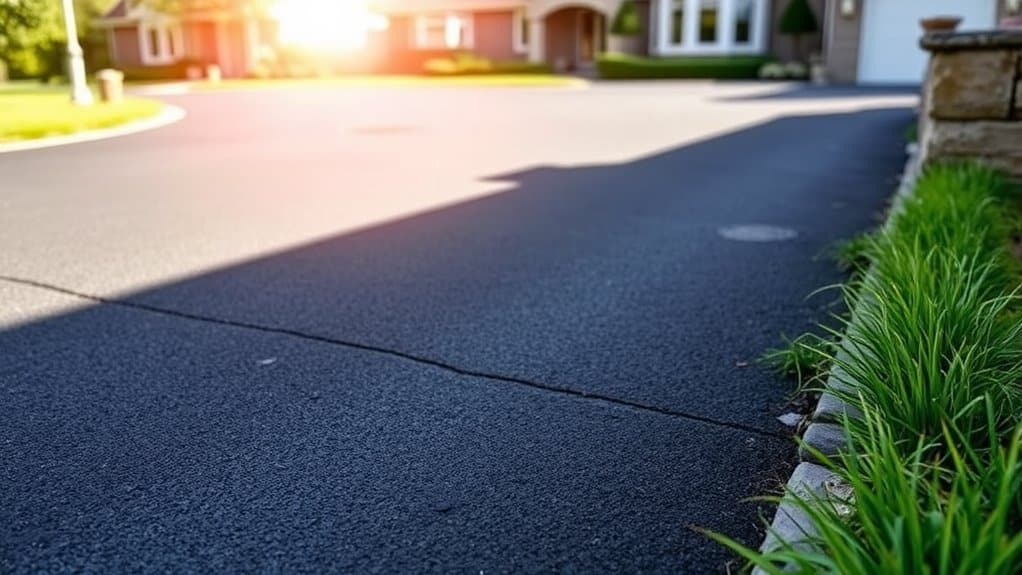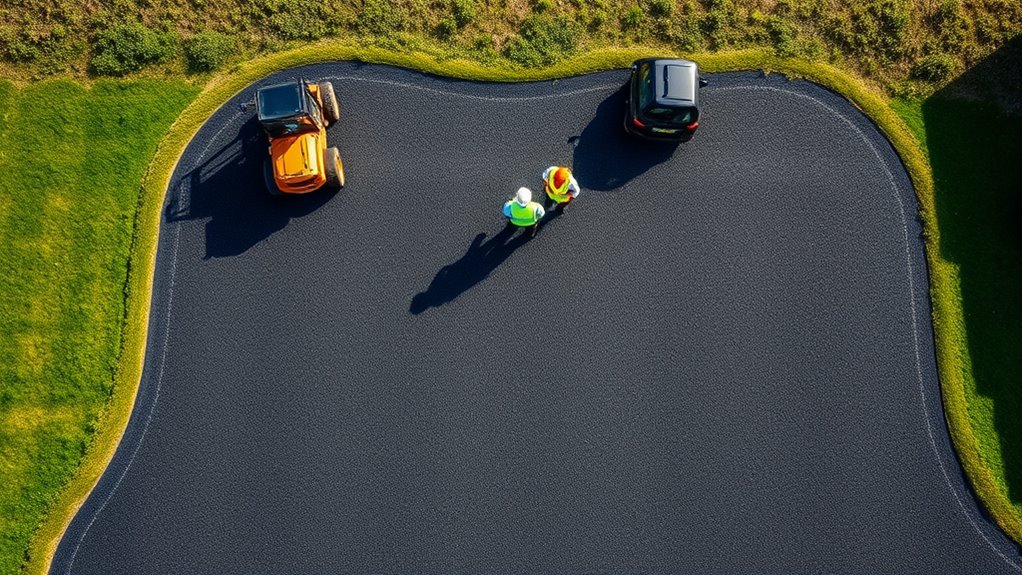To obtain planning permission for a tarmac driveway, start by checking your local council’s regulations, as these can vary. If your property is situated in a conservation area or close to a listed building, you will likely need to apply for permission.
Prepare detailed plans showing the dimensions and materials of the driveway. You can submit your application either online or by post. Be mindful of timelines and any feedback from the council during the process. Understanding these steps is crucial, as there may be challenges along the way.
Table of Contents
ToggleKey Takeaways
- Check your local council’s regulations to see if you need planning permission for a tarmac driveway, particularly if you’re in a conservation area or near a listed building.
- Prepare clear plans that show the dimensions and materials of your driveway, as these are often necessary for your application.
- Submit your planning application online or by post to your local planning authority, ensuring you include all required documentation and fees.
- Keep in mind that decisions on minor applications usually take about eight weeks, so be ready to respond to any feedback from the case officer.
- Remember, not every project needs planning permission thanks to Permitted Development Rights, so confirm your driveway’s status with the local authority.
Understanding Planning Permission for Driveways

When considering adding a driveway, it’s crucial to understand the planning permission requirements set by your local council. This legal step ensures your driveway meets local regulations, supports sustainable development, and maintains the character of the neighbourhood. It’s important to note that planning permission may be required for creating a new driveway or altering access points. Before you start any work, check with your local authority to see if you need planning permission. Engaging with them early can save you time and hassle.
If permission is required, you’ll need to submit detailed plans that outline the dimensions and materials you intend to use. For example, if you’re planning a new gravel driveway, you’ll need to show how it will fit in with the surrounding area and comply with drainage regulations. Ignoring these requirements can lead to fines or legal issues, so it’s essential to follow these guidelines closely to avoid complications down the line.
Factors That May Require Planning Permission
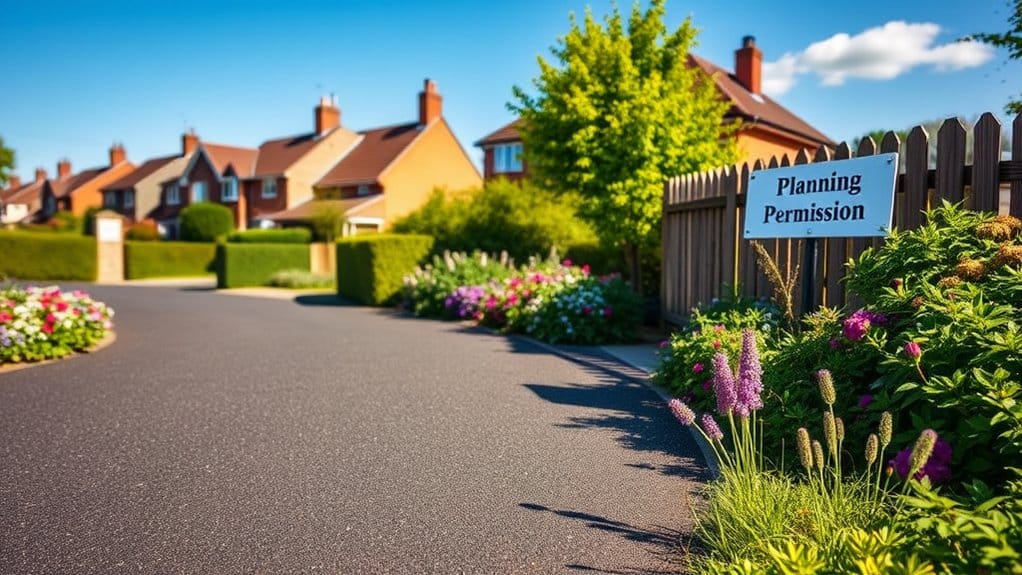
Whether you need planning permission for your driveway depends on several factors.
If your property is in a conservation area or a historic district, you’ll likely need permission due to concerns about visual impact or the environment. Similarly, if you’re making changes near listed buildings, special approval is often required.
The design of your driveway matters as well. Larger driveways that significantly alter your front garden may need permission, especially if you’re using non-permeable materials that could affect drainage. Additionally, most cases will require a driveway permit to ensure compliance with local regulations.
It’s essential to comply with local zoning laws and design standards, as each council has its own guidelines.
Lastly, if your driveway could impact protected areas or local wildlife, you may need special permits to ensure you’re following environmental regulations.
Permitted Development Rights Explained
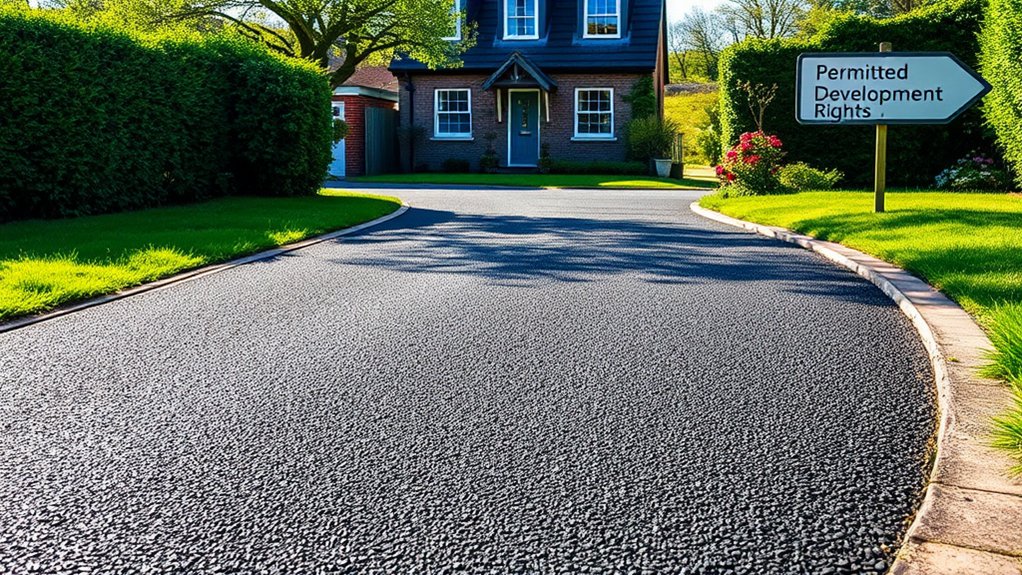
Understanding permitted development rights is crucial for homeowners in the UK looking to make changes to their property without the need for planning permission.
These rights, provided by the government, allow for certain building works—such as extensions or garden sheds—without formal approval. However, they mainly apply to houses and typically exclude flats or leasehold properties, which often face stricter rules. It’s important to remember that development rights may be restricted in designated areas, like Conservation Areas or where Article 4 directions are in place, making planning permission a necessary consideration in those cases.
Always check with your local planning authority to understand the specifics relevant to your situation, especially if you’re planning significant alterations that mightn’t qualify as permitted development.
Key Steps to Apply for Planning Permission
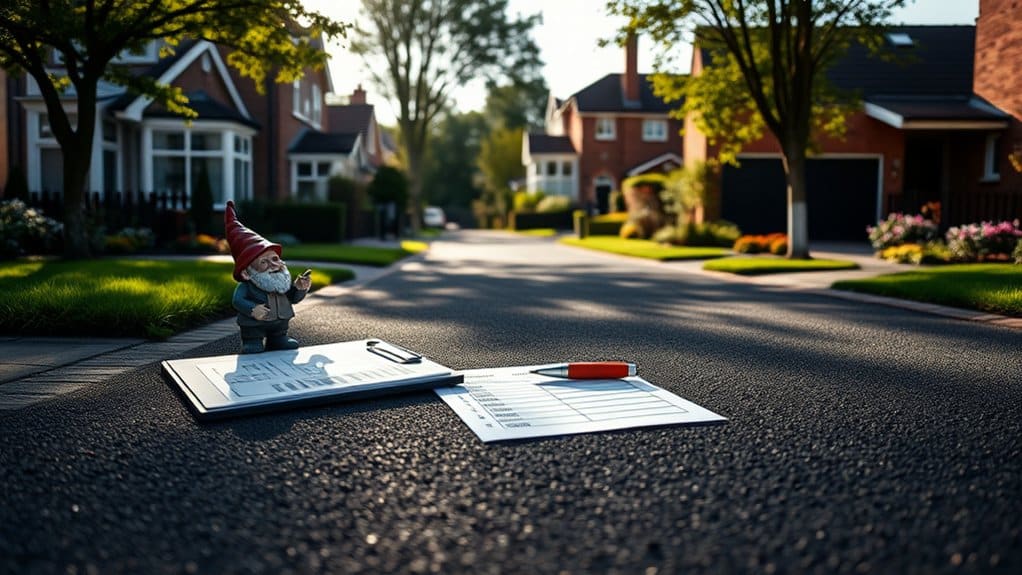
Applying for planning permission for your driveway involves several essential steps to ensure compliance with local regulations.
Start by researching local guidelines, especially if your property is in a conservation area or if your driveway will be larger than five square metres.
Next, gather the necessary documentation, including detailed plans that outline the dimensions and materials of your driveway. Use the standard Planning Portal application form, and remember to factor in any service charges. You can submit your application online or by post if needed.
Keep in mind that the decision timeline is usually around eight weeks for minor applications.
Once submitted, a case officer will review your proposal, which may involve site visits and public consultations.
Stay responsive to any feedback you receive to help ensure a smooth decision-making process.
Common Misconceptions About Planning Permission

Myths about planning permission can cause confusion and lead to costly mistakes for homeowners. A common misconception is that all projects need planning permission. In reality, many renovations, such as small extensions and loft conversions, often fall under Permitted Development Rights (PDR) and don’t require approval.
Another myth is that if a similar structure has been approved, your project will automatically get the green light. Decisions are based on local policies, the character of the neighbourhood, and environmental considerations, so it’s not guaranteed.
It’s also important to note that you don’t always need to own the land to apply for permission. For properties in conservation areas or near listed buildings, stricter regulations apply, making it crucial to clarify these myths.
Consulting your local planning authority can help you navigate the process and avoid common pitfalls.
Challenges in Obtaining Planning Permission
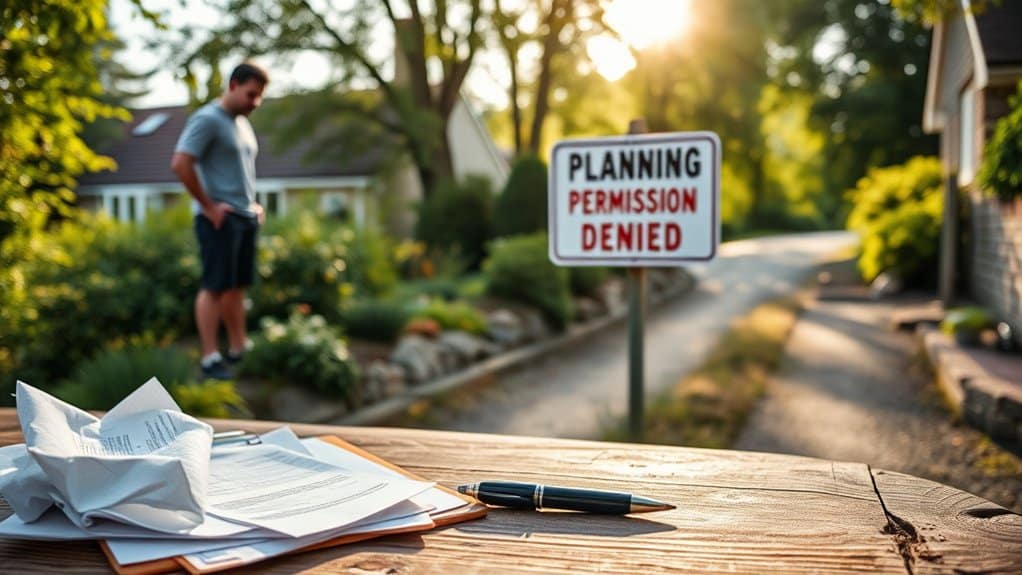
Obtaining planning permission for a driveway might seem simple, but it can be quite complex due to several challenges.
If your property is in a conservation area or near a listed building, you’ll face stricter rules that require detailed applications and possibly extra approvals.
There are also size restrictions; your driveway shouldn’t cover more than 50% of your front garden.
Since local authority guidelines can vary, it’s essential to check your specific regulations.
Environmental factors matter too.
Using impermeable surfaces can cause drainage problems, so you’ll need to comply with Sustainable Urban Drainage Systems.
Lastly, the aesthetics of your driveway are crucial for approval.
You’ll need to choose materials and designs that blend well with your property and the neighbourhood, ensuring they meet community standards while keeping visual impact to a minimum.
Best Practices for a Successful Application

Navigating the complexities of planning permission for a driveway requires a strategic approach to ensure your application is successful.
Start by researching local regulations to ensure your plans meet the necessary guidelines and restrictions. Check if your driveway falls under permitted development rights, which can simplify the process.
Prepare detailed plans that outline dimensions, materials, and effective drainage solutions, ensuring all documentation is accurate.
Engage with planning officers to clarify submission requirements and maintain open communication to resolve any queries.
Listen to feedback from neighbours and local authorities, and be prepared to adjust your plans accordingly.
Lastly, have contingency plans in place for potential delays to keep your application on track.
Importance of Local Regulations and Consultations
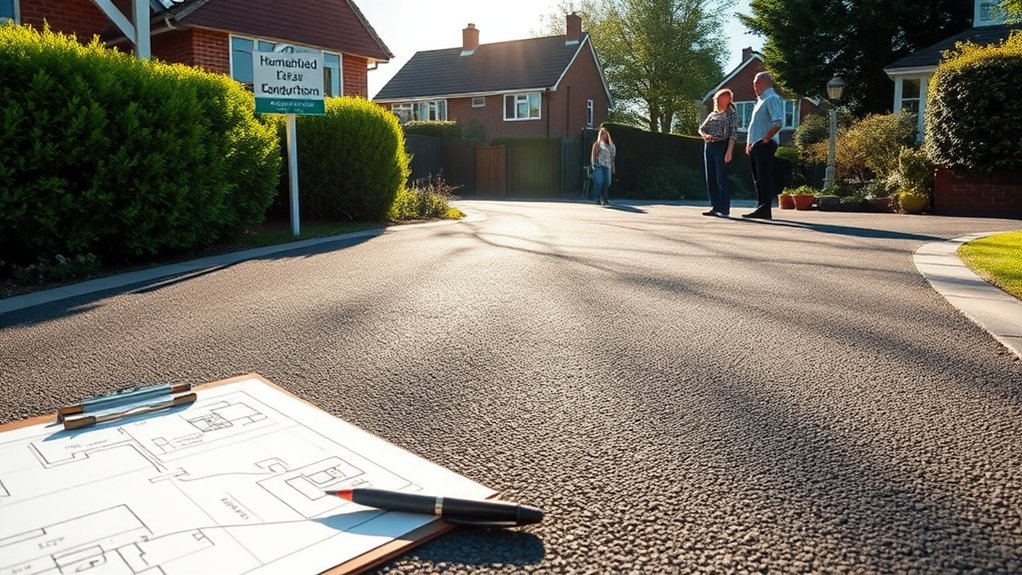
Understanding local regulations and consulting with planning authorities are crucial steps in the driveway planning process, as they directly impact your project’s approval chances.
Compliance with local rules is essential, as regulations can differ significantly across regions. For example, properties located near conservation areas or listed buildings often encounter stricter guidelines.
If your driveway exceeds certain dimensions or incorporates non-permeable materials, you may need planning permission. Early discussions with local planning officers can clarify requirements and highlight potential issues, ensuring your project aligns with environmental and aesthetic standards.
Frequently Asked Questions
How Long Does the Planning Permission Process Typically Take?
The timeline for obtaining planning permission typically spans several weeks. The duration can vary based on factors such as how quickly the local authority processes applications, the complexity of your proposal, and whether further information or changes are required. For instance, a straightforward extension might be approved faster than a new build project, which could involve more scrutiny.
Can I Appeal a Planning Permission Refusal?
If your planning permission has been refused, you can appeal the decision. First, identify valid reasons for the refusal, such as a misinterpretation of local policies or unreasonable conditions imposed by the council. Gather strong supporting documents, like expert opinions or evidence of similar approvals in the area, to bolster your case for reconsideration.
What Happens if I Start Work Without Permission?
Starting work without permission can lead to serious legal repercussions, such as action from local councils. This may result in fines, orders to stop work, and could even affect the value of your property or future projects. For instance, if you build a conservatory without planning permission, you might be required to demolish it. It’s essential to ensure compliance before commencing any work.
Are There Any Exceptions to Applying for Permission?
While some driveway regulations can make your project easier, local guidelines can sometimes add complexity. There are exceptions, such as permeable surfaces or minor extensions, which may not require permission. However, it’s essential to verify specific conditions to prevent any unforeseen issues.
How Can I Speed up My Planning Permission Application?
To expedite your planning permission application, ensure you provide comprehensive documentation, seek pre-application advice from your local council, and respond to any feedback quickly. For instance, if the council requests additional information or changes, addressing these promptly can significantly speed up the process. Following these straightforward tips can improve your chances of a quicker approval.
Conclusion
Navigating the planning permission process for a tarmac driveway can be daunting, but it doesn’t have to be complicated. Start by familiarising yourself with local regulations, as requirements can vary across different councils. For example, if your driveway will cover more than five square metres and you’re not using permeable materials, you will likely need planning permission.
Consulting with your local authority can clarify what you need, and it’s wise to engage professionals who know the ins and outs of the system. Don’t let misinformation steer you off course; instead, arm yourself with accurate details and best practices. With thorough preparation, you can successfully submit your application and bring your driveway project to life.
How can a tarmac driveway enhance your home's appeal? Discover the key aspects of cost, installation, and maintenance in our Read more
Just how long can you expect your tarmac driveway to last? Discover key factors and maintenance tips that can extend Read more
From planning to final touches, discover the essential steps of tarmac driveway installation—what could go wrong if you skip any Read more



